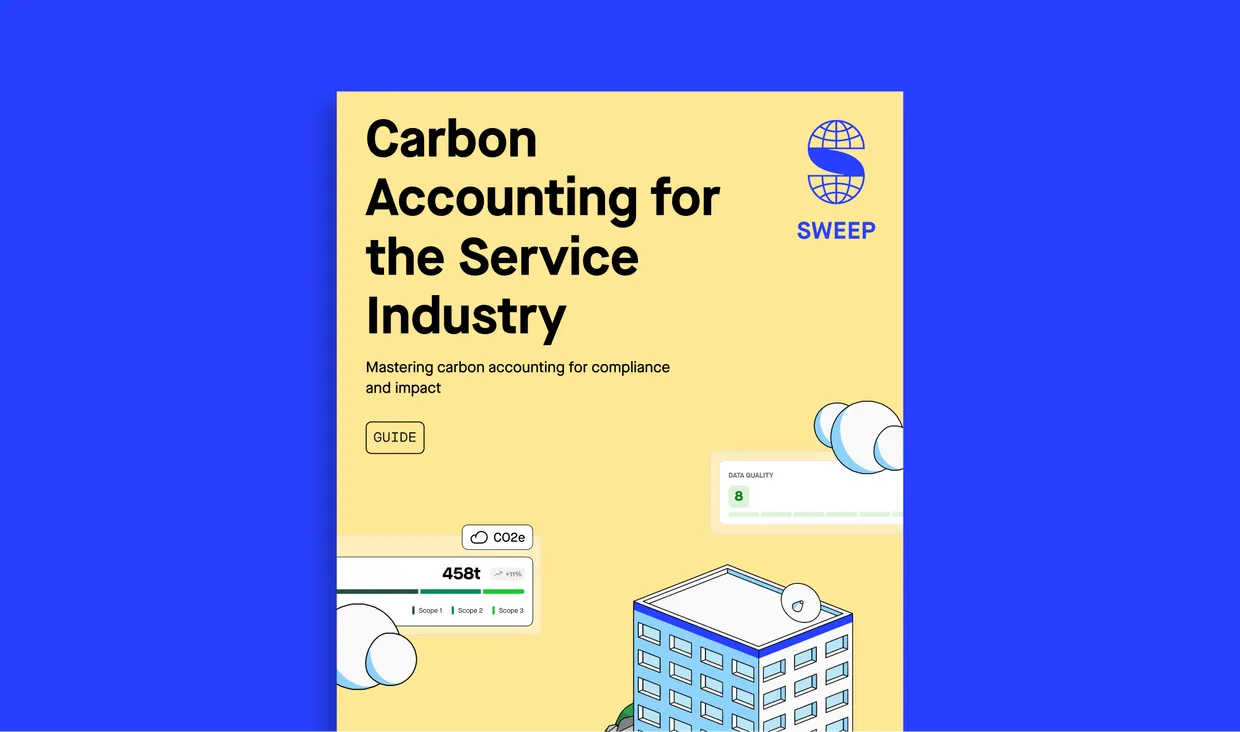More and more companies are starting to manage, report and reduce their greenhouse gas emissions. That’s because it makes good business sense.
What exactly is carbon accounting?
Carbon accounting refers to the process of measuring, recording, and reporting the amount of greenhouse gasses (GHGs) that are emitted or removed from the atmosphere by your company. The goal is to identify the sources and amounts of emissions so that you can take effective action to reduce them and mitigate environmental change.
Doing this right does take effort and dedication, but it’s a necessity, both for your business and for our future. Here are the five steps to getting started with carbon accounting, and creating a credible, meaningful climate programme.
Step 1: Organize yourself
Effective carbon accounting starts with getting your bearings and the first step is conducting a GHG inventory.
Understand your greenhouse gas inventory
To create a GHG inventory, there are four steps to follow.
Firstly, you need to determine the scope of the inventory and consider who will be using it. This requires making choices about reporting and organizational boundaries, which can affect the value of the information for readers.
Secondly, you must establish a quality control system for your GHG inventory to make it auditable, which includes collecting documentation and periodically checking the data quality. You will also need to document the procedures for creating the inventory, including a base-year review and recalculation policy.
Thirdly, as you begin to more accurately measure your activities, you will need to select emission factors and allocate them to an emission category and reporting entity. Once you have sufficient carbon emissions data for a reporting period, you can establish it as a base-year and regularly check for events that require recalculating the emissions.
Lastly, you can compile your GHG report, which describes your organization’s GHG-related activities for the intended user. The report should include information on your organization’s background, the reporting period covered, GHG emissions, reductions, and changes that occurred since the last reporting period.
Set your greenhouse gas emissions baseline
A key step in carbon accounting is establishing a baseline, which is the amount of greenhouse gas emissions released by your company in a specific reference year. This baseline serves as a reference point for future years, allowing you to track progress in reducing emissions. Typically, the baseline encompasses all relevant sources of carbon dioxide emissions, and is expressed in a common unit such as metric tons of carbon dioxide equivalent (CO2e). By comparing your emissions in subsequent years to your baseline, you can assess the effectiveness of your efforts to reduce your carbon footprint.
Involve your team in carbon accounting
Next, because decarbonization is a collective challenge, involve staff in your carbon accounting journey. Make sure everyone from the C-Suite to the mail room is involved. Let everyone know what you’re doing and why, and inspire and incentivise them to do their bit.
You could even “gamify” your climate programme by introducing some friendly competition. A fully stocked (organic, locally sourced) beer fridge for the team who reduces the most emissions, for example, might be just the incentive people need.
Go beyond your business boundaries
Carbon accounting doesn’t end at your factory gate or reception desk. Every activity that keeps your business running contributes, and that includes those by third parties such as suppliers and customers (see Scope 3, below). Delivering your office equipment, for example, or producing the raw materials you buy – this all counts as your carbon footprint.
Opening a dialogue with your suppliers might help them find ways to reduce their own carbon footprint – and collaborate with you on lessening your impact on the climate.
Dos and don’ts
-
Do chart your organization first then map your emissions to that.
-
Don’t just leave carbon accounting to the sustainability team. Get everyone on board.
-
Do start a dialogue with external partners and suppliers.

Step 2: Measure your GHG emissions
The next step is calculating GHG emissions. But to do that, first you need to work out where they come from. Emissions come under one of three scopes:
Scope 1
Direct emissions that come from sources you own or control. Say your company has a fleet of cars or your manufacturing plant is powered by a furnace. The fuel combustion emissions will come under this scope.
Scope 2
Indirect emissions that come from any electricity consumption, steam, heating and cooling that your company purchases.
Scope 3
Everything not included in scope 1 or 2. These emissions are either upstream or downstream.
Upstream emissions
-
Purchased goods and services
-
Capital goods (including tools and machinery)
-
Raw material transportation
-
Generated waste
-
Business travel
-
Employee commutes
-
Leased assets
Downstream emissions
-
Transport and distribution of your product to consumers
-
Processing of sold products
-
Use of sold products
-
Disposal or recycling of sold products
-
Franchises
-
Investments
Why measure Scope 3 emissions?
When it comes to calculating GHG emissions, no company can afford to address scopes 1 and 2 alone. Why? Because scope 3 is likely to be where most of your emissions come from. Samsung, for example, knows that 61% of its carbon dioxide emissions are scope 3. For Coca-Cola European Partners (CCEP) it’s 93%. That’s a lot of potential right there for reducing corporate emissions further – and at the same time improving efficiency and lowering costs.
How to measure your emissions
Now that you understand where your carbon emissions come from you can start to measure them. Time to meet the carbon accounting equation:
Activity data x emission factor = tCO2e
tCO2e stands for tonnes of CO2 equivalent. That’s the amount of GHG your business activity emits. It’s ‘CO2 equivalent’ because it can be used to measure CO2 or any other GHG.
The best method for establishing a baseline measurement for your greenhouse gas emissions depends mostly on the data at your disposal and the resources available for tracking and measuring emissions. Below, we give you an overview of the four key ways to calculate your carbon footprint.
Industry average data – These are sectoral emissions factors, or averages of the emission data submitted by organizations operating in a given sector. They can be used as a starting point for carbon footprint calculations in the absence of more accurate data.
Spend-based – This is based around the cost of purchased goods or services. The value is multiplied by a given emission factor to calculate an estimate of your total indirect emissions. Spend-based emission factors are derived from an industry average of emission levels usually at a national level. This means they aren’t super accurate. On the plus side, spend-based methodology is relatively simple to implement and can provide a useful approximation of your company’s indirect emissions.
Supplier-based – As this is primary data, it is the most accurate form of Scope 3 accounting. It involves tracking the emissions from individual suppliers, and then using that data to calculate the emissions associated with your company’s purchased goods and services.
Hybrid – The hybrid method uses a mix of the above methodologies. It usually presents a fairly accurate picture of your total emissions, but it can be complex and resource-intensive to implement.
And it’s a good idea to gather and enter your data on a daily or weekly basis and generate reports regularly (rather than leaving it all till your year-end report). Before you know it, it will be part of your everyday business routine.
Your supply chain and data collection challenges
Below are some of the common challenges that companies encounter when trying to measure emissions accurately across their value chain.
-
Collecting data: Accurate GHG accounting on your full Scope 3 carbon footprint means engaging with many stakeholders, all of whom are likely to have different types of climate data.
-
Managing data: Managing and analyzing large amounts of disparate climate data and integrating this with your existing systems can be difficult and time-consuming.
-
Engaging stakeholders: With many conflicting business priorities, it’s often hard to get buy-in both internally and externally for value chain carbon measurement.
Tackling supply chain emissions is about having a strong dialogue and good governance.
The collective goal should be to make sure your customer-supplier relationships revolve around more than just pricing. Why? Because when we add a climate-action dimension to this relationship it benefits both sides.
Suppliers: Showing a commitment to climate action is increasingly a prerequisite to winning new business.
Customers: Engaging suppliers in emissions measurement and reduction helps companies improve their reputation, make smarter procurement decisions, and comply with the latest climate regulations.
Dos and don’ts:
-
Don’t wait to do it once a year
-
Do include all your scope 3 emissions
-
Do follow an accounting standard
Setting net zero targets
Planetary net zero is when the amount of emissions being released into the atmosphere is equal to that being removed. Emissions are removed naturally by carbon sinks such as the ocean, trees and soil, or by artificial methods, such as direct air capture.
Setting net zero goals for companies is very different. It’s when you set a date for when your emissions will match the amount of carbon you reduce or remove. But be careful about claiming to have achieved net zero emissions for your company, given that your scope 3 emissions come from your suppliers, customers and entire value chain.

Step 3. Reduce your carbon emissions
At this stage you should have a clear picture of your carbon footprint, how big it is and where it’s coming from. After carbon accounting comes the important step of reducing greenhouse gas emissions. There are two things that you can do:
-
Reduce: Lower the emissions that your business activity produces
-
Contribute: Support climate projects that are reducing or removing GHG emissions
The key to a successful climate programme is to do both of these. Every company needs to first focus on actively reducing its emissions, and then have a carbon purchasing strategy in place. This double approach is crucial if the planet is to reach net zero by 2050.
Why reduce when you can contribute?
It might be tempting just to carry on emitting as much greenhouse gas as usual and compensate for it by purchasing negative carbon elsewhere. But the truth is that we’ll never reach planetary net zero this way. Here are just two of the reasons why:
-
We don’t have time: We need to half global greenhouse gas emissions by 50% by 2030. A tree, while it is great at absorbing carbon, will only do so slowly and gradually over its lifetime.
-
We don’t have unlimited storage capacity: Most emerging technologies, such as direct air capture, need carbon sinks to store the captured carbon (in rock, for example). But the total storage capacity of the planet is only a fraction of the total emissions we produce.
So it’s important that we all focus on reducing our own emissions first. And then, to buy us time, we need to make contributions to climate projects, too.
Set your target
The UN’s Intergovernmental Panel on Climate Change (IPCC) says that the world needs to reach net-zero by 2050 in order to limit global warming to 1.5C and reduce environmental impact. So that’s the goal to align with.
First, set a big, headline target for the whole company to aim for. Then you can set separate targets for different teams and parts of your business.
A note on science based targets
Science based targets (SBTs) are ambitious emissions reduction goals set by the Science-Based Targets initiative. They are designed to align your carbon accounting with the objectives of the Paris Agreement on climate change. Through a rigorous scientific methodology, SBTs calculate how much we need to lower GHG emissions to prevent global temperatures from rising more than 1.5°C above pre-industrial levels. More and more companies across various industries are adopting SBTs as they recognize the urgency to take bold action on climate change. By setting SBTs, you are not only reducing your environmental impact but also improving your reputation and demonstrating your commitment to sustainability, which is increasingly crucial to investors, consumers, and other stakeholders.
Benchmark: ENGIE
Just one example of a SBTi target is the one set by ENGIE. The service, business energy and regeneration company has committed to reducing its power-generation GHG emissions from scope 1 and scope 3 by 52% per kWh between 2017 and 2030. It has also committed to reducing absolute scope 3 emissions from use of sold products 34% by 2030 from a 2017 base year.
Act on your pledges
Now you’ve set your targets, all you have to do is reach them! The focus of your reduction initiatives will depend on your business and where your emission “hotspots” are. But here are some of the pathways you can take:
Supply chains
As we’ve seen, there’s plenty of reduction potential in your supply and value chain. The key is to communicate and engage with your suppliers to pinpoint where emissions come from, and collaborate on reducing them.
Data from the Carbon Disclosure Project (CDP) reveals that your supply chain emissions are on average 11.4 times greater than the direct emissions produced by your own operations. Since these emissions represent a significant portion of your overall carbon footprint, it’s crucial to incorporate them into your carbon management and reporting efforts and leverage them to drive climate action.
Taking action to reduce your Scope 3 GHG emissions can also provide several business advantages. For instance, carbon accounting can help you make informed procurement decisions by identifying suppliers committed to climate action and avoiding allegations of greenwashing. Effective carbon measurement can also identify areas of high emissions and enable you to implement energy efficiency measures, leading to cost reductions. Additionally, as some countries already require mandatory reporting of Scope 3 emissions, taking action to reduce emissions now can ensure regulatory compliance and increase your regulatory resilience.
Renewable energy
Commit to using only clean energy. The holy grail of sustainability is to generate this energy yourself rather than buying it. That means becoming an equity investor in energy projects, buying long-term power purchase agreements – or building the wind farms and solar plants yourself.
Energy efficiency
Monitor your energy usage across your facilities and do what you need to do help you your energy consumption and reduce it. Replace old heating systems and repair leaks. Switch to low-carbon transport for shipping. And design any new buildings to be energy efficient.
Product design
If your business involves making physical products, you can cut emissions by sourcing recycled or renewable materials, by reducing waste, and by designing them to use less material in the first place. And the longer they last, the lower their carbon footprint.
Product mix
Some products are simply bad for the environment. In that case, look at switching up your product mix – from cars to a car-sharing service, for example, or from meat burgers to vegan burgers.
Dos and don’ts
-
Don’t focus on only reduction or only contribution – do both
-
Do set targets based on the latest science
-
Do use cleaner energy – and less of it

Step 4: Contribute to selected projects
The last piece of the puzzle is contribution – the second key to reaching global net zero. That means making payments to projects that remove or reduce carbon emissions.
The IPCC has stated clearly that carbon removal and reduction projects are essential to limiting global warming to 1.5°C. And, as a company, no matter how hard you can reduce carbon emissions, you won’t cut your emissions to zero – at least not within the timescale we need.
What’s in a word? Carbon offsets vs contributions
The business community is moving away from “carbon offsets” and leaning towards “contributions”. The terminology is important, because different language shapes different approaches.
Offsetting, while well intended, can raise the wrong expectations. It implies that you can pay another company to remove their emissions, or suck carbon out of the air with a high-tech device, instead of curbing your own. And then claim you are ‘net zero’ or ‘carbon neutral’ (see above).
But when you contribute, you’re investing in solutions that tackle climate change, and contributing to global efforts to reach planetary net zero. But you’re not using it as a replacement for reduction.
We propose a three step process to build a strategic portfolio of climate projects:
1. Set a contribution budget based on an internal carbon tax
This budget incorporates an internal carbon tax that generates revenue proportional to your company’s greenhouse gas emissions. The tax has three primary elements: the cost, the extent of application, and its impact on decision-making. You have the freedom to establish your internal carbon price or tax, which could be based on the tax rate in your area of operation, the emissions trading system (ETS), or a calculation of the social cost of carbon. However, the tax must have a positive trend to convey a clear message about the financial advantages of minimizing your carbon footprint. Therefore, setting an ascending internal carbon price or tax would emphasize the economic benefits of reducing your company’s carbon emissions.
2. Allocate funds strategically to support climate positive initiatives
By instituting an internal carbon price, you can regulate your actual expenses rather than purchasing carbon credits based on market prices. Developing and distributing the budget cooperatively with a contribution strategy encourages involvement from all members of your organization. This is an excellent method of fostering a sense of cohesion to enhance your company’s ecological influence and instilling in employees a sense of accountability for their individual effects.
3. Build a relevant and impactful portfolio of carbon credits
Now that you have taken control of your climate action budget, it’s time to focus on the nature of the projects you want to endorse. Acquiring carbon credits proves to be more effective when you actively engage in the selection of climate projects that are pertinent to your business and have an authentic local influence. Consider the following three factors when selecting climate projects for your contribution portfolio:
-
Align your project selection with your company’s principles and location. For example, if your company has branches in France and Canada and suppliers in Vietnam and Japan, supporting climate projects in these countries could be an option.
-
Analyze the country’s decarbonization plan, also known as Nationally Determined Contributions (NDCs), as they identify significant concerns and priorities to meet national climate targets. These may encompass reducing industrial emissions, forest conservation, or transitioning towards sustainable agriculture.
-
Projects should be of high quality and address local ecological and social concerns. In the spirit of global solidarity, opt for verified projects implemented in regions where the local population is in urgent need of support. Most developing countries do not necessarily require more trees but require assistance to ensure food security or access to energy.
Dos and don’ts
-
Do assess each project according to what matters to you
-
Do look for projects where your contribution has impact
-
Don’t think of contributing as a replacement for reducing

Step 5: Communicate your climate impact
A good climate programme is a transparent one. You need to report GHG emissions according to accounting standards, and you need to show both internal and external stakeholders how far you’ve progressed.
The most common accounting standards for emissions are aligned with ISO 14064-1, such as the Greenhouse Gas Protocol. Do this regularly and often, and you’ll always be on top of your climate programme.
A note on the GHG Protocol
The GHG Protocol is a widely-used international accounting tool for measuring, managing, and reporting greenhouse gas emissions. It was developed by the World Resources Institute (WRI) and the World Business Council for Sustainable Development (WBCSD) and is recognized as the international standard for greenhouse gas (GHG) accounting and reporting.
A note on the carbon disclosure project
The Carbon Disclosure Project (CDP) is a non-profit organization that operates a global environmental disclosure system. Its main objective is to encourage companies and cities to disclose their environmental impacts, risks, and opportunities to investors, policymakers, and the general public. The CDP provides a platform for companies to report their carbon emissions data, climate risks, and management strategies to a wide range of stakeholders. It also collects data on other environmental issues such as water and forest management, which can have an impact on a company’s long-term sustainability.
Reporting GHG emissions
So you’ve hunted down your emissions, set your targets, and acted on your promises. Now it’s time to let everyone know about it. Publish your report and share it with stakeholders. Spread the word on social media and tell your employees to keep them engaged.
But before you do, be mindful of what you’re saying. Nowadays, consumers and investors are good at spotting greenwashing. And legislation is ramping up by the day, so make sure you’ve put in the work before you make any claims.
What’s crucial is to be open and transparent and share what knowledge we have with others in the business community. The road to net zero is, after all, a trip we’re all taking together, and it’s a long, continuous learning curve.
Dos and don’ts
-
Do be transparent, no matter how well you’re doing
-
Do share what you’ve learned with other companies
-
Don’t fall into the greenwashing trap

Conclusion
The best way to start carbon accounting is to just do it (and the sooner the better, because before long, it will be illegal not to). We’re at a crucial turning point, and the momentum is building to figure out together how to deal with climate change before it’s too late.
It’s much better to be on the inside of the movement, where you can benefit from networks, knowledge-sharing and good will, than on the wrong side of history.
And, while cleaning up your carbon might feel like a huge (and possibly expensive) task, the long-term benefits include lower costs, a more efficient business, happier employees and happier customers. It is, quite simply, good for business.
Carbon accounting software such as Sweep can play a huge role in simplifying the process of calculating your GHG emissions.
Find out more about how we can help you get started.




